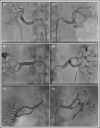Renal denervation beyond the bifurcation: The effect of distal ablation placement on safety and blood pressure
- PMID: 28296025
- PMCID: PMC8030832
- DOI: 10.1111/jch.12989
Renal denervation beyond the bifurcation: The effect of distal ablation placement on safety and blood pressure
Abstract
Renal denervation may be more effective if performed distal in the renal artery because of smaller distances between the lumen and perivascular nerves. The authors reviewed the angiographic results of 97 patients and compared blood pressure reduction in relation to the location of the denervation. No significant differences in blood pressure reduction or complications were found between patient groups divided according to their spatial distribution of the ablations (proximal to the bifurcation in both arteries, distal to the bifurcation in one artery and distal in the other artery, or distal to the bifurcation in both arteries), but systolic ambulatory blood pressure reduction was significantly related to the number of distal ablations. No differences in adverse events were observed. In conclusion, we found no reason to believe that renal denervation distal to the bifurcation poses additional risks over the currently advised approach of proximal denervation, but improved efficacy remains to be conclusively established.
Keywords: hypertension-general; optimized treatment; renal denervation.
©2017 Wiley Periodicals, Inc.
Figures


Comment in
-
Finding the best ablation strategy for renal denervation: A continuing saga.J Clin Hypertens (Greenwich). 2017 Apr;19(4):379-380. doi: 10.1111/jch.12981. Epub 2017 Mar 21. J Clin Hypertens (Greenwich). 2017. PMID: 28322494 Free PMC article. No abstract available.
References
-
- Krum H, Schlaich M, Whitbourn R, et al. Catheter‐based renal sympathetic denervation for resistant hypertension: a multicentre safety and proof‐of‐principle cohort study. Lancet. 2009;373:1275–1281. - PubMed
-
- Esler MD, Krum H, Sobotka PA, et al. Renal sympathetic denervation in patients with treatment‐resistant hypertension (The Symplicity HTN‐2 Trial): a randomised controlled trial. Lancet. 2010;376:1903–1909. - PubMed
-
- Esler MD, Krum H, Schlaich M, Schmieder RE, Böhm M, Sobotka PA. Renal sympathetic denervation for treatment of drug‐resistant hypertension: one‐year results from the Symplicity HTN‐2 randomized, controlled trial. Circulation. 2012;126:2976–2982. - PubMed
-
- Bhatt DL, Kandzari DE, O'Neill WW, et al. A controlled trial of renal denervation for resistant hypertension. N Engl J Med. 2014;370:1393–1401. - PubMed
-
- Desch S, Okon T, Heinemann D, et al. Randomized sham‐controlled trial of renal sympathetic denervation in mild resistant hypertension. Hypertension. 2015;65:1202–1208. - PubMed
MeSH terms
LinkOut - more resources
Full Text Sources
Other Literature Sources

